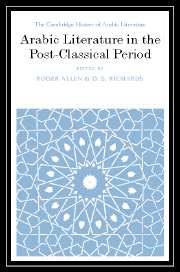Book contents
- Frontmatter
- The post-classical period: parameters and preliminaries
- Part I Elite Poetry
- Part II Elite prose
- 5 Pre-modern belletristic prose
- 6 The essay and debate (al-risāla and al-munāzara)
- 7 The maqāma
- 8 Mamluk history and historians
- 9 Historiography in arabic during the ottoman period
- Part III Popular poetry
- Part IV Popular prose
- Part V Drama
- Part VI Criticism
- Bibliography
- Index
- References
9 - Historiography in arabic during the ottoman period
from Part II - Elite prose
Published online by Cambridge University Press: 28 March 2008
- Frontmatter
- The post-classical period: parameters and preliminaries
- Part I Elite Poetry
- Part II Elite prose
- 5 Pre-modern belletristic prose
- 6 The essay and debate (al-risāla and al-munāzara)
- 7 The maqāma
- 8 Mamluk history and historians
- 9 Historiography in arabic during the ottoman period
- Part III Popular poetry
- Part IV Popular prose
- Part V Drama
- Part VI Criticism
- Bibliography
- Index
- References
Summary
The Ottoman Occupation of the Central Arab Lands
The Ottoman empire in a few decisive battles destroyed the Mamluk sultanate (1250–1517), which included Egypt, Syria and parts of Anatolia (with the Hijaz within its sphere of influence). Egypt, the centre of empires since the Fatimids, and Syria as well, became taxpaying Ottoman provinces for the next three, nominally four, centuries. Later in the sixteenth century, the Yemen, Iraq and North Africa (with the exception of Morocco) were also incorporated into the Ottoman empire with varying degrees of centralism and firmness.
For Egypt in particular the change of rule was traumatic. It is true that, like the Mamluks, the Ottomans were Turcophone, Sunnis and ruled by a foreign-born military caste. But the Mamluk regime had become thoroughly familiar, and the Mamluk sultans and amirs were a localized elite, unlike the Ottomans who administered the provinces from Istanbul. The language of administration under the Mamluks was Arabic; under the Ottomans it became Turkish. Under the new regime, all governors, chief government officials, qādīs and soldiers came from the Turkish provinces and spoke Turkish. Thus, the foreign presence in the Arab lands was much more massive than before. Even worse, many of the natives of Syria, Egypt and other Arab lands regarded the Ottomans as bad Muslims, negligent of the religious ordinances and disrespectful of the Sharia, the holy law of Islam. This judgement automatically entailed a view of the rulers as unjust. Later, this negative image of the Ottomans greatly changed, as the Ottomans, starting with the long and enlightened reign of Sultan Sulaymān Qānūnī (the Magnificent, 1520–66), became more devout, partly owing to the conquest of the Arab lands, where they found ancient and venerated centres of Muslim culture and learning.
- Type
- Chapter
- Information
- Arabic Literature in the Post-Classical Period , pp. 171 - 188Publisher: Cambridge University PressPrint publication year: 2006
References
- 2
- Cited by



